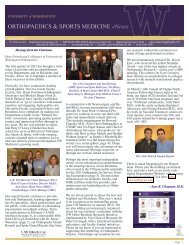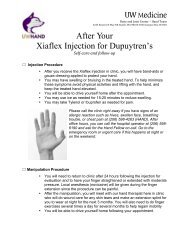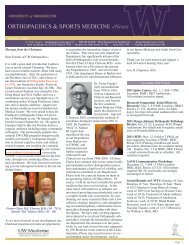2002 - University of Washington Bone and Joint Sources
2002 - University of Washington Bone and Joint Sources
2002 - University of Washington Bone and Joint Sources
Create successful ePaper yourself
Turn your PDF publications into a flip-book with our unique Google optimized e-Paper software.
intercollegiate rowing has increased<br />
over the last 25 years <strong>and</strong> may reflect a<br />
complex, interrelated set <strong>of</strong> changes in<br />
the sport over time, including changes<br />
in equipment, type <strong>and</strong> intensity <strong>of</strong><br />
training, <strong>and</strong> rower physique, as well as<br />
beginning to row at a younger age.<br />
Nevertheless, ergometer training for<br />
longer than 30 minutes proved to be the<br />
most significant <strong>and</strong> consistent<br />
predictor <strong>of</strong> back pain, in every age<br />
decade <strong>and</strong> when all potential<br />
predictors were considered<br />
simultaneously.<br />
This duration <strong>of</strong> ergometer training<br />
recently has become widespread due to<br />
increased ergometer availability <strong>and</strong> to<br />
st<strong>and</strong>ardized training protocols<br />
dispensed by US Rowing. Coaches<br />
suggest that ergometer training is more<br />
difficult than rowing in the boat, <strong>and</strong><br />
that technique deteriorates during long<br />
ergometer sessions.<br />
In addition to longer ergometer<br />
training times, height is significantly<br />
associated with back pain only in our<br />
female rowers. Although we don’t know<br />
if the height increase is a function <strong>of</strong><br />
torso length or leg length, greater torso<br />
length creates increased leverage that is<br />
advantageous for rowing, but may be<br />
disadvantageous for the spine. The legs<br />
initiate the drive phase <strong>of</strong> rowing<br />
during which the trunk-thigh angle<br />
must increase. Ideally, the quadriceps<br />
extend the knee while the hamstrings<br />
simultaneously rotate the trunk.<br />
Quadriceps dominance can lead to the<br />
buttocks moving back in the boat<br />
prematurely, thus hyperflexing the<br />
lumbar spine (“shooting the tail”).<br />
Hyperflexion also occurs when<br />
hamstrings are hyperflexible or when<br />
the scapular-stabilizing muscles are not<br />
strong enough to receive the force<br />
transferred from the lower limbs. Spine<br />
hyperextension occurs when the rower<br />
increases the trunk-thigh angle by<br />
extending the spine using spinal<br />
muscles rather than by rotating the<br />
pelvis posteriorly through the hip<br />
joints. Quadriceps dominance <strong>and</strong><br />
hamstring hyperflexibility noted in<br />
female athletes may make<br />
compensating for increased leverage in<br />
the taller female rower more difficult.<br />
Koutedakis et al <strong>and</strong> Colli<strong>and</strong>er et al<br />
found a correlation between thighmuscle<br />
imbalance <strong>and</strong> back pain.<br />
Moreover, Koutedakis et al significantly<br />
reduced time loss due to back pain by<br />
instituting a hamstring-strengthening<br />
program in 22 female rowers. To protect<br />
the spine, balanced strength <strong>and</strong> good<br />
rowing technique are critical.<br />
CONCLUSION<br />
Back pain in intercollegiate rowing<br />
has increased over the last 25 years<br />
affecting 32% <strong>of</strong> 1632 intercollegiate<br />
rowers in our study. The effect on the<br />
affected athlete’s team is significant. In<br />
our study, 5.8% <strong>of</strong> rowers missed more<br />
than a month or the entire competitive<br />
season. Whether this back pain causes<br />
lifelong problems is the subject <strong>of</strong><br />
additional data analysis underway.<br />
RECOMMENDED READING<br />
Colli<strong>and</strong>er EB <strong>and</strong> Tesch PA: Bilateral<br />
eccentric <strong>and</strong> concentric torque <strong>of</strong><br />
quadriceps <strong>and</strong> hamstring muscles in<br />
females <strong>and</strong> males. Eur J Appl Physiol<br />
1989;59:227-232.<br />
Hickey GJ, Fricker PA, <strong>and</strong> McDonald<br />
WA: Injuries to elite rowers over a 10-<br />
yr period. Med Sci Sports Exerc<br />
1997;29(12): 1567-1572.<br />
Howell DW: Musculoskeletal pr<strong>of</strong>ile<br />
<strong>and</strong> incidence <strong>of</strong> musculoskeletal<br />
injuries in lightweight women rowers.<br />
Am J Sports Med 1984; 12(4): 278-282.<br />
Huston LJ <strong>and</strong> Wojtys EM:<br />
Neuromuscular Performance<br />
Characteristics in Elite Female Athletes.<br />
Am J Sports Med 1996;24(4): 427-436.<br />
Koutedakis Y, Frischknecht R <strong>and</strong><br />
Murthy M: Knee flexion to extension<br />
peak torque ratios <strong>and</strong> low-back<br />
injuries in highly active individuals. Int<br />
J Sports Med 1997; 18:290-295.<br />
Lamb DH: A kinematic comparison <strong>of</strong><br />
ergometer <strong>and</strong> on-water rowing. Am J<br />
Sports Med 1989; 17(3): 367-373.<br />
<strong>2002</strong> ORTHOPAEDIC RESEARCH REPORT 49















